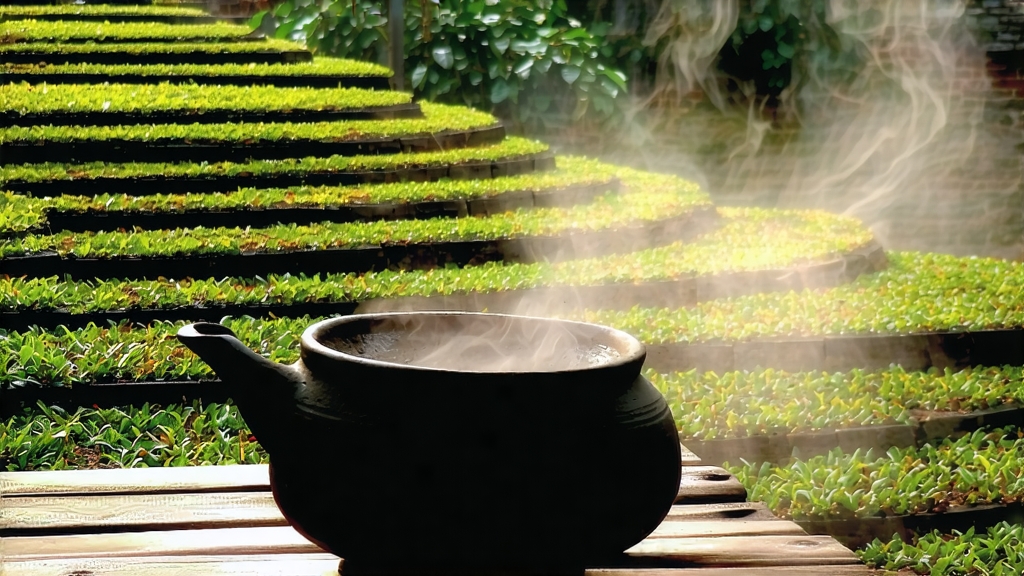
Tucked away in the humid, karst-pocked southwest of China, the small district of Liu Bao in Guangxi Wuzhou has been quietly producing one of the oldest and most misunderstood members of the dark-tea family. To most Western drinkers “dark tea” evokes images of Yunnan’s shou puer, yet a century ago Liu Bao bingcha travelled the same ancient trade routes, braved the same malarial rivers, and satisfied the same Mongolian and Tibetan thirst for “border tea.” Today, as puer auctions shatter price records, Liu Bao remains a bargain, its history, craft and flavour still waiting to be decoded by an international palate.
History: From Imperial Tribute to Maritime Ballast
The first written mention appears in the 1585 edition of the Wuzhou Gazetteer: “Tea from Liu Bao, dark as lacquer, sweet as longan, forwarded to the capital.” By the Qing dynasty the leaves were compressed into 37 kg bamboo baskets, loaded onto flat-bottomed river boats and rowed down the Guijiang to Guangzhou. There, East-India captains discovered that the baskets made excellent ballast; the tea absorbed less bilge water than porcelain and arrived in Java, Singapore and Calcutta already partially aged by the tropical voyage. Sailors called it “boat tea,” and colonial apothecaries prescribed it for dysentery. In 1886 the Canton Customs Office recorded 4,300 tonnes of Liu Bao exported—more than Keemun and Lapsang combined. Two world wars and the Japanese occupation severed the maritime chain, and Liu Bao slipped into domestic obscurity until Guangxi state farms revived the craft in 1958.
Micro-terroir: Why Mist Matters
Liu Bao sits at 23 °N, 300–500 m above sea level, where warm, wet air from the South China Sea meets the granite spine of the Yunkai Mountains. Annual rainfall exceeds 1,800 mm, but the porous karst drains quickly, forcing tea roots to dive deep for mineral-rich groundwater. The native cultivar—Camellia sinensis var. sinensis “Liu Bao Qunti”—bears small, tenacious leaves with a unique ratio of chlorophyll-b to anthocyanins, giving the finished tea its trademark burgundy-black lustre and a naturally low astringency. Locals insist that the same leaf grown ten kilometres away, outside the mist belt, never develops the betel-nut aroma.
Harvest Calendar: Five Seasons in One Leaf
Unlike puer, which is picked in two flushes, Liu Bao is harvested in five micro-seasons:
- Mingqian (before Qingming): the rarest, sweetest buds for tribute-grade.
- Yuqian (before Grain Rain): standard grade, balanced polyphenols.
- Chunwei (late spring): high catechins, destined for long aging.
- Guhua (autumn osmanthus bloom): floral undertones, favoured by Hong Kong cellars.
- Dongpian (winter “solar” pick): only on windless, sunny days; tiny yield, maximum umami.
Craft: The Secret of Double Fermentation
The process begins like green tea: leaves are withered 4–6 hours, wok-fired at 280 °C for eight minutes to kill green enzymes, then rolled until 40 % cell rupture. What happens next is unique. The damp leaf is piled 70 cm deep inside a bamboo-lined chamber and covered with wet jute sacks. Indigenous microbes—primarily Aspergillus niger, Blastobotrys adeninivorans and a novel yeast designated Liu Bao Kazachstania-3—kick off a 10-hour “wet-pile” fermentation. Temperature is allowed to spike to 55 °C before tea masters “fan” the pile with rice-straw hats, introducing oxygen and halting the thermophilic sprint. The half-fermented leaf is then sun-dried to 14 % moisture, steamed, and packed into 37 kg bamboo baskets lined with fresh banana leaves. A second, slower fermentation unfolds during years of warehouse aging; the banana leaf enzymes oxidise slowly, imparting a subtle fruity note that connoisseurs compare to dried longan and camphor.
Grades & Shapes: Beyond the Basket
Although the bamboo basket (lóng) remains iconic, Liu Bao is now pressed into four commercial shapes:
- San-cha (loose): ages fastest, favoured by Guangdong